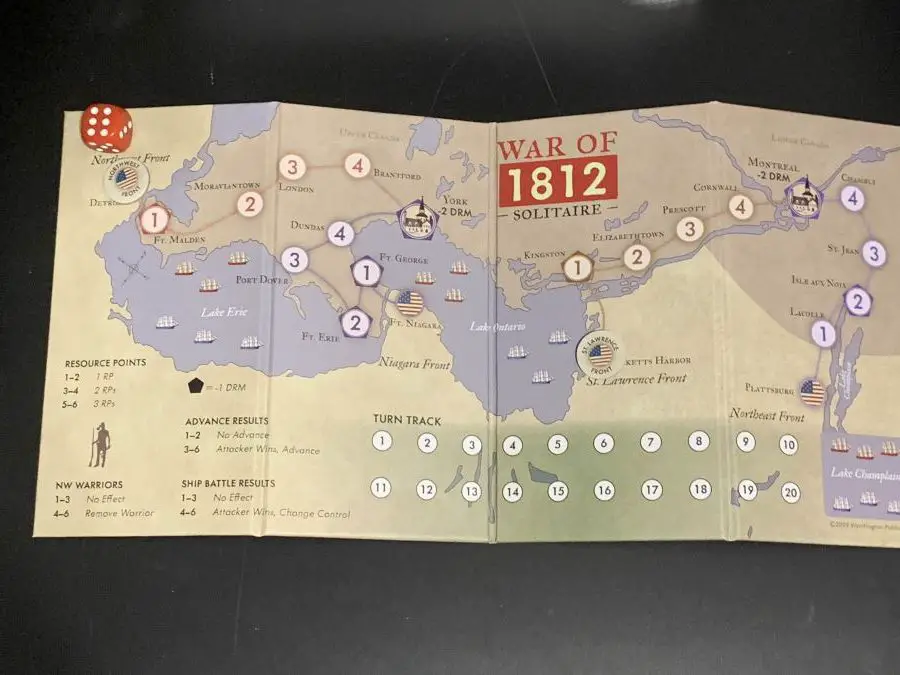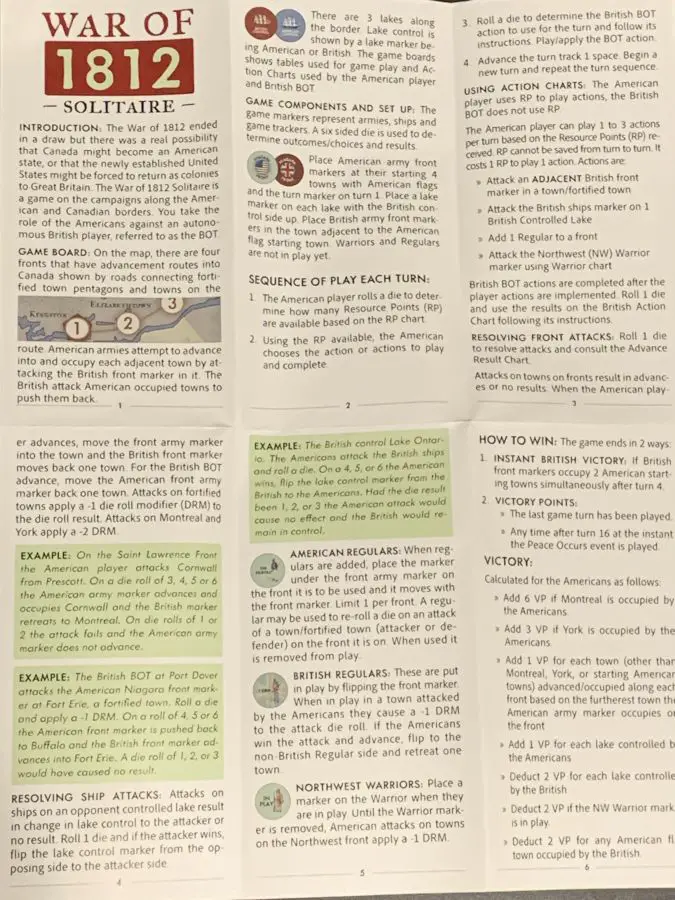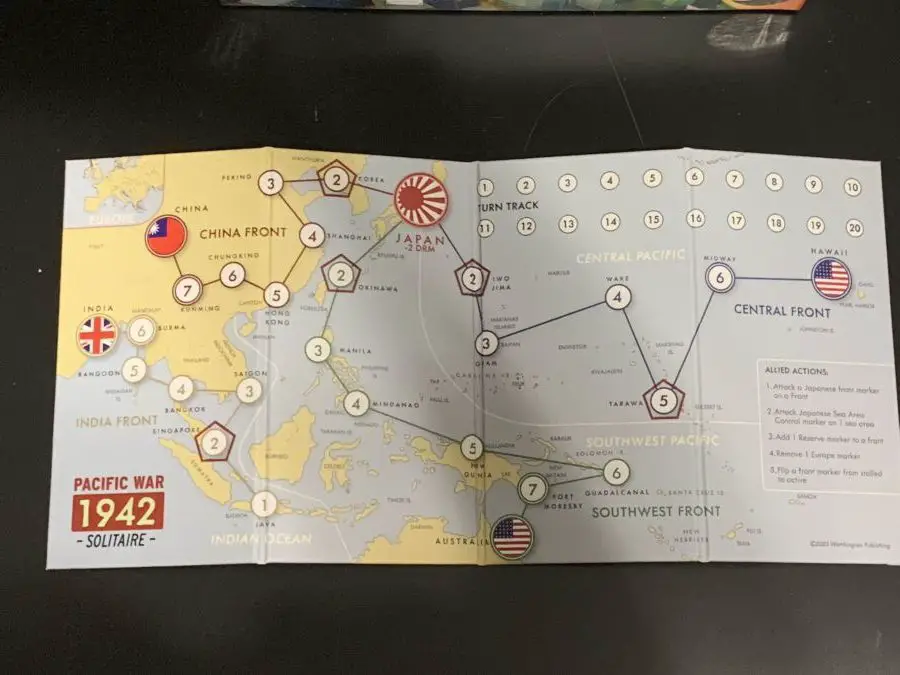
Pacific War 1942 and War of 1812 are two solitaire games by Worthington Publishing. Although these games are very similar, their differences can be summarized by a few rule changes and the use of different game boards. The settings are completely different as well. They share a review because the games are so similar that your purchasing choice will have to come down to which setting you like better. I prefer the Pacific War, but both games are equally well-made and of high quality. The boxes are pretty small and can fit into a good-sized purse.
Both games contain a set of game tokens, red dice, the rules sheet, and cardboard sheets with rules on the back. Although the contents of the boxes are nearly identical on the surface, the game board, cardboard rule sheets, and tokens are specific to each game.
War of 1812

In the War of 1812, you take control of American forces trying to invade and occupy Canada. You’re up against the British forces and they’re controlled by AI. You’ll be doing all the rolling for yourself and the British forces. This game takes 30 minutes or fewer to complete. After running it a few times, I can run the game in 25 minutes.

Before you start playing, you have to make sure to place the game markers on their appropriate spot on the game board. You get a set of game markers that represent the American and British armies. You also get a few tokens that represent the lakes. Place the American army front markers at their starting 4 towns with the American flags and move the turn market to 1. Next, place a lake market on each lake with the British control side up. Finally, place British army front markers in the town adjacent to the American flag starting town. After doing all of this you’re good to go.
The game is extremely straightforward. The American player rolls a die to determine how many Resource Points are available based on the RP chart located on the game board. Next, use the RP you have available to choose the action or actions to play and complete. After that, roll a die to determine the British action to use for the turn and follow its instructions, make sure to play or apply the action that the British got. Finally, advance the turn track 1 space.
You can win the game in two ways. If the British front markers occupy 2 American starting towns simultaneously, that is considered an instant British victory. You can also make it to turn 16 and anytime after that an instant Peace Occurs. When all is said and done calculate the VP by using the instructions on the bottom of the rules.
There isn’t anything too crazy about this game. The rules are laid out nicely and nothing is too complicated. I really liked the end of the rules that provided some context for the war. It helped set the mood a lot. The game mechanics are solid too! There is a lot of replayability here, but I found myself getting bored of the setting quickly.
Pacific War 1942

Pacific War 1942 includes a game board, a red die, game tokens, and cardboard rules sheets. To set up the game, place Allied front markers in locations along the tracks in locations with double circles (this is extremely clear when you’re looking at the game board.) You’re looking to place the tokens on spots that have the same markings as Burma. After that, place the Japanese front markers on the locations specified in the rules. Next, place Japanese Sea Area Control markers in each sea area and the turn marker on turn 1.
The sequence of play is very similar to the War of 1812 game. First, the Allied player rolls a die to determine how many Action Points are available using the chart on the game board. After that, you use the Action Points to choose the action or actions to play and complete. When that’s done, roll a die to determine the Japanese action to use for the turn and follow its instructions. Finally, advance the turn track 1 space and repeat.
I prefer the Pacific War because of the setting and the artwork. The game board looks prettier to me and I love the art on the back of the rules sheets. I think that the game board is more fun to move around too but aside from that, both games are pretty similar.
Final Thoughts
These two games are not war simulator games, so if that’s what you’re looking for, these games aren’t for you. You’re not getting a deep simulation of events and you can play both of these games without any knowledge of the wars.
I found that there isn’t any strategy to be had here and for games that play this quickly, that’s completely fine. These games are both simple, portable, and extremely accessible. If you pick up one to play, you can pick up the other and have no issues diving in. Yes, there are some minor rules variations, but they don’t make learning each game difficult in any way. In both games the bot is formidable, I appreciate that a lot because the game would’ve gotten stale much quicker if the bot wasn’t designed right.
I also found that the War of 1812 was more difficult because you get 40 actions. Regardless, once I got the hang of both games, the difficulty became null and void. The dependency on the dice makes both games pretty predictable and for that reason, I found myself having to pack these games up and leave them alone for a bit. Don’t get me wrong, I love these games and they’re a lot of fun but they’re also too light and predictable for me to enjoy in the long term.
You can fit these games into a suitcase or a good-sized purse. Honestly, I would leave one in the car just in case I wanted to play on the go. They’re the perfect size for travel and for that reason alone I could recommend the game. The other big thing they have going for them is that they’re pretty easy to learn and once you learn one you can play them both. The cardboard rules sheets provide quick access to the rules and how turn order happens: Something that I think is brilliant and adds to how easy these games are to pick up and play.
Pacific War 1942
Excellent
The Pacific War of 1942 and the War of 1812 are two travel solitaire games that I highly recommend having in your collection. These games ooze charm and polish and have a good amount of replayability for those who like lighter games.
Pros
- Lightweight and easy to travel with.
- Once you learn one game, you can play them both.
- Both games are fair and balanced.
Cons
- Both games can get repetitive.
- There is very little strategy to be had in either game.
